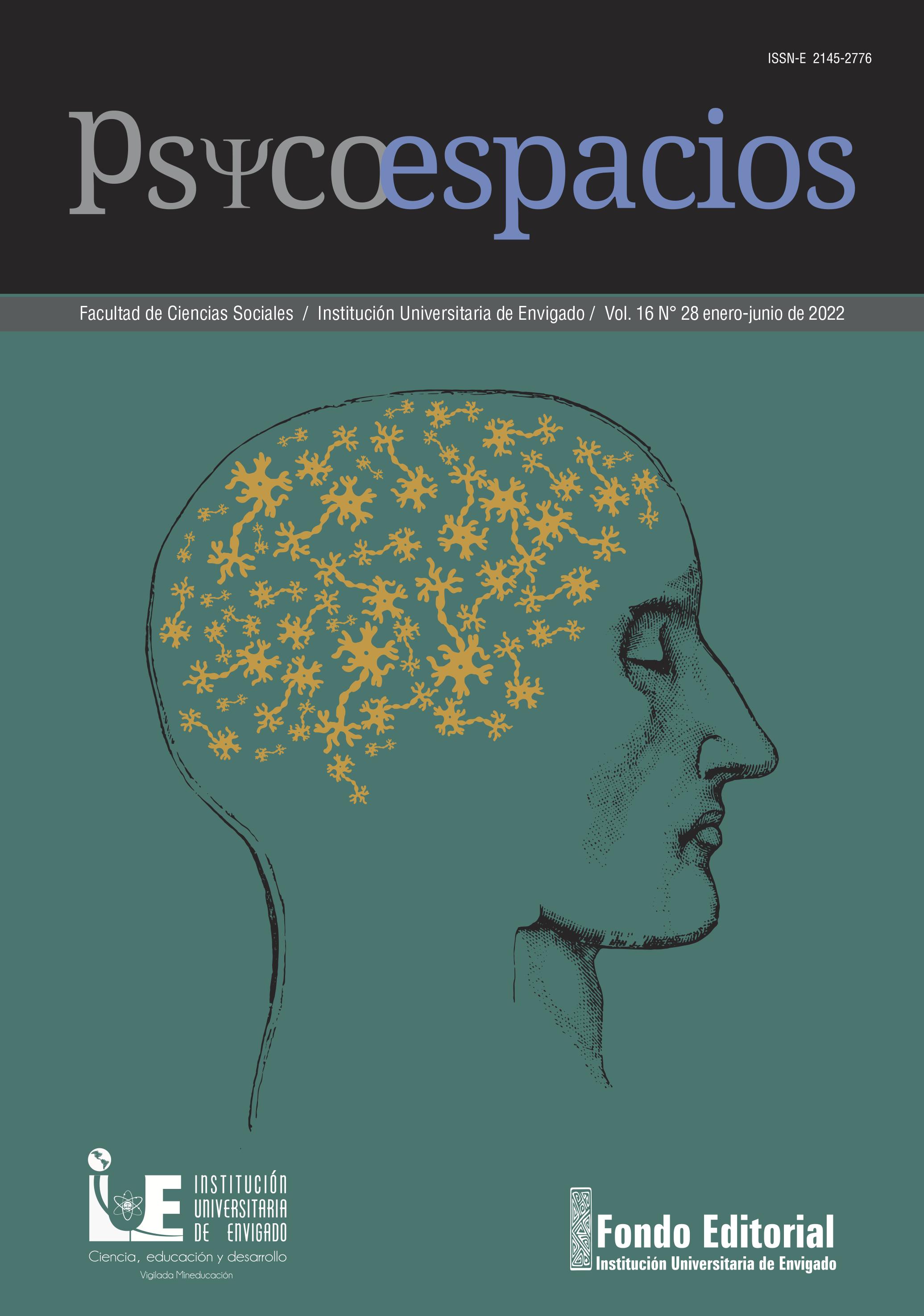Use of social networks and internalization of the thin ideal in adolescent women
DOI:
https://doi.org/10.25057/21452776.1454Keywords:
Adolescents, social networks, internalization, thinnessAbstract
The study examines the relationship between the internalization of the thin ideal and the frequency of exposure to social networks in adolescent females between 16 and 19 years old, living in the metropolitan area of Buenos Aires, Argentina. This is an empirical study with a cross-sectional quantitative approach and correlational scope, which used the Sociocultural Attitudes Towards Appearance Questionnaire-3 (SATAQ-3) and the Cuestionario de frecuencia del uso de redes sociales. As a hypothesis, it is proposed that adolescent women show high use of social networks, at the same time presenting high levels of internalization of the thin ideal and the existence of a significant relationship between the frequency of use of social networks and the internalization of the thin ideal. The mean use of social networks by adolescent women correlates positively with the information and general internalizing domains of the SATAQ-3. Usage is significantly, positively, low and moderately associated with reaching millions of users with the message of the thin sociocultural ideal. A relationship can be concluded between the internalization of the thin ideal and the use of social networks in adolescent women. The greater the exposure to social network content, the greater the internalization of sociocultural attitudes about appearance. Further research is recommended to use more instruments that assess body image dissatisfaction, body surveillance, body control behaviors and objectification.
Author Biographies
Analia Veronica Losada, Pontificia Universidad Católica Argentina
Dra. en Psicología, Pontificia Universidad Catolica Argentina
Vicedecana Facultad de Psicología y Ciencias Sociales de la Universidad de Flores, Argentina
Profesora Titular en la Universidad de Flores -UFLO- Argentina
Profesora Titular, Pontificia Universidad Catolica Argentina
ORCID: https://orcid.org/0000-0003-0488-4651
Correo electrónico: analia_losada@yahoo.com.ar
Sofia Stamatiou, Pontificia Universidad Católica, Argentina
Licenciada en Psicología de la Pontificia Universidad Católica Argentina
ORCID: https://orcid.org/0000-0001-5054-8523
Correo electrónico: stamatiousofia23@gmail.com
Micaela Victoria Potes, Pontificia Universidad Católica, Argentina
Licenciada en Psicología de la Pontificia Universidad Católica, Argentina
ORCID: https://orcid.org/0000-0001-7155-3292
Correo electrónico: micaelapotes@hotmail.com
References
Arab, L. E.; Díaz, G. A. (2014). Impacto de las redes sociales e internet en la adolescencia: aspectos positivos y negativos. Revista Médica Clínica Las Condes, v. 26, n. 1, 7-13. https://doi.org/10.1016/j.rmclc.2014.12.001
Arias Gómez, J.; Villasís Keever, M.; Miranda Novales, M. (2016). El protocolo de investigación III: la población de estudio. Revista Alergia México, v. 63, n. 2, 201-206. https://doi.org/10.29262/ram.v63i2.181
Bandura, A.; Walters, R. H. (1987). Aprendizaje social y desarrollo de la personalidad. Alianza Editorial.
Blasco Expósito, N. (2017). Evaluación de la satisfacción corporal en mujeres en relación con los hábitos de ejercicio físico [tesis de maestría, Universidad de Jaén]. https://hdl.handle.net/10953.1/6220
Brea Folgar, A. L. (2019). Corporalidad online-offline. Revisión sistemática de la influencia de Instagram en la imagen corporal de los adolescentes [tesis de maestría, Universidad Autónoma de Barcelona]. https://hdl.handle.net/2072/351171
Buse Montero, S. (2019). La internalización de ideales de belleza y la auto-cosificación del cuerpo en mujeres adolescentes de Lima [trabajo de pregrado, Pontificia Universidad Católica del Perú]. http://hdl.handle.net/20.500.12404/14612
Coolican, H. (2017). Research methods and statistics in psychology. Psychology press.
Fatt, S. J., Fardouly, J., & Rapee, R. M. (2019). # malefitspo: Links between viewing fitspiration posts, muscular-ideal internalisation, appearance comparisons, body satisfaction, and exercise motivation in men. New Media & Society, 21(6), 1311-1325.
Feltman, C. E.; Szymanski, D. M. (2018). Instagram Use and Self-Objectification: The Roles of Internalization, Comparison, Appearance Commentary, and Feminism. Sex Roles, n. 78, 311-324. https://doi.org/10.1007/s11199-017-0796-1
Festinger, L. (1983). The human legacy. Columbia University Press.
Fontemachi Cornejo, M. A. (2014). Prevención de adicciones tecnológicas en adolescentes argentinos [tesis doctoral, Universidad de Valencia]. https://trobes.uv.es/permalink/34CVA_UV/um6gse/alma991009438510606258
Fredrickson, B. L., & Roberts, T. A. (1997). Objectification theory: To ward understanding women's lived experiences and mental health risks. Psychology of Women Quarterly, 21, 173-206
García de Bayas, A. B. (2019). Influencia de las redes sociales en la insatisfacción corporal en la adolescencia [trabajo de pregrado, Universidad de Jaén]. https://hdl.handle.net/10953.1/9804
García del Castillo, J. A. (2013). Editorial: adicciones tecnológicas: el auge de las redes sociales. Salud y Drogas, v. 13, n. 1, 5-13. https://doi.org/10.21134/haaj.v13i1.188
Hernández Sampieri, R.; Fernández Collado, C.; Baptista Lucio, P. (2014). Metodología de la investigación. McGraw Hill.
Infante Faura, J. del R.; Ramírez Luna, C. M. (2017). Uso de Facebook y la autopercepción de la imagen corporal en mujeres. Avances en Psicología, v. 25, n. 2, 209-222. https://doi.org/10.33539/avpsicol.2017.v25n2.356
Lijtinstens, C. (2015). La devastación por las imágenes… Cazadores de identidad/ 7 cajas. Virtualia, v. 4, n. 30, 1-3. http://www.revistavirtualia.com/articulos/103/dossier-enapol-el-imperio-de-las-imagenes/la-devastacion-por-las-imagenes-cazadores-de-identidad-7-cajas
Llorente, E.; Gleaves, D. H.; Warren, C. S.; Pérez de Eulate, L.; Rakhkovskaya, L. M. (2015). Translation and Validation of a Spanish Version of the Sociocultural Attitudes Towards Appearance Questionnaire-4 (SATAQ-4). International Journal of Eating Disorders, v. 48, n. 2, 170-175. https://doi.org/10.1002/eat.22263
Lucciarini, F.; Losada, A. V.; Moscardi, R. (2021). Anorexia y uso de redes sociales en adolescentes. Avances en Psicología, v. 29, n. 1, 33-45. https://doi.org/10.33539/avpsicol.2021.v29n1.2348
Mills, J. S.; Musto, S.; Williams, L.; Tiggemann, M. (2018). Selfie” harm: Effects on mood and body image in young women. Body Image, n. 27, 86-92. https://doi.org/10.1016/j.bodyim.2018.08.007
Murawski, B.; Elizathe, L.; Custodio, J.; Rutsztein, G. (2015). Validación argentina del Sociocultural Attitudes Towards Appearance Questionnaire-3. Revista Mexicana de Trastornos Alimentarios, v. 6, n. 2, 73-90. https://doi.org/10.1016/j.rmta.2015.09.001
Murawski, B. M.; Elizathe, L. (2013). Ideal de delgadez y creencias disfuncionales acerca de la imagen corporal. En V Congreso Internacional de Investigación y Práctica Profesional en Psicología. XX Jornadas de Investigación. Noveno Encuentro de Investigadores en Psicología del MERCOSUR. Universidad de Buenos Aires. https://www.aacademica.org/000-054/261
Murawski, B. M.; Rutsztein, G. (2017). Internalización del ideal de delgadez y autoestima en pacientes mujeres con Trastorno Alimentario de Buenos Aires. En IX Congreso Internacional de Investigación y Práctica Profesional en Psicología. XXIV Jornadas de Investigación. XIII Encuentro de Investigadores en Psicología del MERCOSUR. Universidad de Buenos Aires. https://www.aacademica.org/000-067/319
Romo del Olmo, M. (2020). Influencia de las redes sociales en la satisfacción de la imagen corporal de las adolescentes. Un proyecto de prevención [trabajo de pregrado, Universidad de Cádiz]. http://hdl.handle.net/10498/23419
Sabucedo, J. M.; Morales Domínguez, J. F. (2015). Psicología Social. Editorial Médica Panamericana.
Saffon, S.; Saldarriaga, L. M. (2014). La internalización del ideal de delgadez: factor de riesgo de alteraciones de la imagen corporal y los hábitos de alimentación, generado por la influencia de los pares. Revista de Psicología Universidad de Antioquia, 6, 1, 75-90. https://revistas.udea.edu.co/index.php/psicologia/article/view/21618
Schaefer, L. M., Burke, N. L., Thompson, J. K., Dedrick, R. F., Heinberg, L. J., Calogero, R. M., & Swami, V. (2015). Development and validation of the sociocultural attitudes towards appearance questionnaire-4 (SATAQ-4). Psychological assessment, 27(1), 54-67, 10.1037/a0037917
Sherman, L. E.; Payton, A. A.; Hernandez, L. M.; Greenfield, P. M.; Dapretto, M. (2016). The Power of the Like in Adolescence: Effects of Peer Influence on Neural and Behavioral Responses to Social Media. Psychological Science, v. 27, n. 7, 1027-1035. https://doi.org/10.1177/0956797616645673
Skinner, B. F. (2000). Walden dos. Martínez Roca.
Thompson, J. K.; van den Berg, P.; Roehrig, M.; Guarda, A. S.; Heinberg, L. J. (2004). The Sociocultural Attitudes towards Appearance Scale-3 (SATAQ-3): Development and Validation. The International Journal of Eating Disorders, v. 35, n. 3, 293-304. https://doi.org/10.1002/eat.10257
Yuni, J. A.; Urbano, C. A. (2014). Técnicas para investigar. Recursos metodológicos para la preparación de proyectos de investigación. Editorial Brujas.
How to Cite
Downloads
Published
Issue
Section
License
Copyright (c) 2022 Institución Universitaria de Envigado

This work is licensed under a Creative Commons Attribution-NonCommercial-ShareAlike 4.0 International License.
| Article metrics | |
|---|---|
| Abstract views | |
| Galley vies | |
| PDF Views | |
| HTML views | |
| Other views | |





